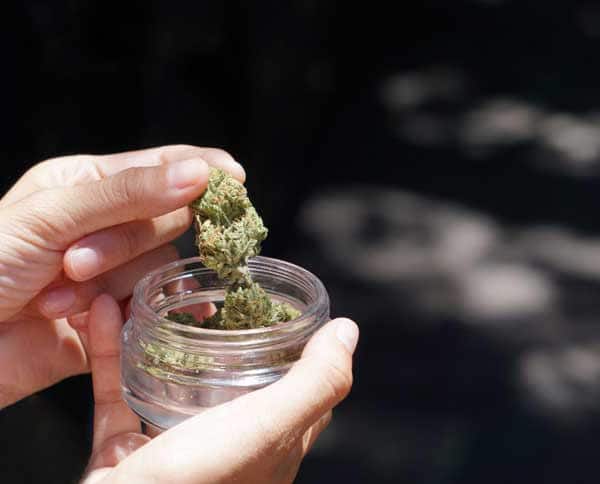Curing cannabis is an important step in botanical processing. Not only does it affect the taste, smell, and overall quality of your product but also has implications for its longevity and shelf life. In this article we will look at dry vs wet trimming, breaking down the plant material, aroma preservation techniques using jars, temperature and humidity control as well as experiences from professional cannabis farmers to get a better understanding of how curing works. Get ready to learn more about curing cannabis.
Dry vs Wet Trimming
When it comes to botanical processing, trimming can be done either dry or wet – the former being more common in commercial production while the latter often requires manual labor. Dry trimming is the most common method used in commercial production, while wet trimming is often done by hand and can be a more labor-intensive process.
Tools Needed:
For dry trimming, specialized machines are used to cut away excess leaves from the buds or flowers of the plant material. These machines can range from large industrial equipment to smaller tabletop models that offer precision control over the amount of material removed. Wet trimming requires only scissors or shears for cutting off excess foliage and removing any remaining stems.
Harvesting:
The timing of harvesting your cannabis plants play an important role in determining how much material needs to be trimmed off during either process. If your cannabis harvest is premature, it may require additional pruning due to immature growth; if harvested too late, plants will have begun producing seeds that need to be removed prior to processing. It’s essential that farmers take into account their crop’s maturity when deciding when best to harvest their product for optimal results with minimal waste materials needing removal later on down the line.
When it comes to dry vs wet trimming, the decision should be based on preference and desired outcome. Breaking down the plant material is a more detailed process that requires knowledge of chlorophyll, bacteria, and starch content in order to create an optimal end product.

Breaking Down the Plant Material
Chlorophyll, the green pigment found in cannabis plants, is a vital component of photosynthesis and helps to maintain terpene levels for taste and aroma. It also preserves, as it helps keep terpenes from evaporating away. A combination of heat, pressure, and water can be used to break down the chlorophyll molecules during processing, resulting in a reduction of any possible bitterness from consuming raw cannabis flowers or extractions.
Bacteria:
Bacteria are microscopic organisms that can have a negative effect on cannabis products if not handled properly during processing. To prevent bacteria growth, processors should use proper sanitation techniques such as sterilizing equipment and keeping temperatures below 50°C (122°F). Additionally, storing processed material at low humidity levels will help reduce the risk of contamination because bacteria are more prevalent in humidity.
Starch is a carbohydrate found in most plants like cannabis. During processing, starch can contribute to undesirable flavors when heated above 160°C (320°F). To avoid this issue, processors must take extra care when heating materials containing starch by keeping temperatures below 160°C (320°F) or utilizing vacuum ovens that operate at lower temperatures than traditional ovens while still achieving desired results.
Breaking down the plant material is an essential step in botanical processing and requires careful attention to detail. By utilizing proper storage techniques, such as burping jars, one can ensure that the cannabis retains its aroma for optimal curing results.
Jars and Aroma Preservation Techniques
It’s essential to use the right techniques to preserve the taste and aroma of cannabis over time. Burping is one technique used to maintain freshness in jars, which involves opening them briefly each day to release any built-up pressure or moisture; this helps prevent mold growth while also allowing air to circulate within the jar. To maximize preservation, store jars away from direct sunlight and at a consistent temperature between 65-75 degrees Fahrenheit with low humidity levels (below 65%).

When it comes to storage requirements, glass mason jars are ideal as they provide an airtight seal that can help keep out unwanted contaminants like dust or pests. They’re also easy to clean and come in various sizes so you can choose what works best for your needs. Additionally, consider using vacuum-sealed bags when storing cannabis in bulk as this will help reduce oxygen exposure and preserve the quality over time.
To cure cannabis correctly, burping jars and keeping them in a dim, well-ventilated space can help maintain the quality for an extended duration. Maintaining the correct temp and humidity levels is essential for attaining the desired aroma and flavor in your cured cannabis.
Temperature and Humidity Control for Curing Cannabis
Temperature and humidity control are essential when curing cannabis, and being consistent is the only way to get the desired outcome of properly cured cannabis. When it comes to time considerations, there is no one-size-fits-all approach as different strains require varying lengths of cure times. Generally speaking, longer cure times will produce a better end product; however, it can take anywhere from four weeks up to six months depending on the strain and desired effects.
When drying cannabis humidity levels should be kept between 55% – 65%. If the humidity level is too high or low, it can cause mold growth or drying out which will ruin your crop. To ensure that you maintain proper humidity levels during the curing process, use a hygrometer/thermometer combo device that measures both temperature and relative humidity simultaneously.
This way you can make sure your environment stays within the ideal range throughout the entire process without having to guess or manually check multiple times per day. Additionally, using burping jars with silica gel packets inside them helps keep moisture at bay while also allowing air exchange so that terpenes remain intact for maximum flavor and aroma preservation.
Overall, controlling temperature and humidity are key components in achieving top-quality cannabis products with desirable flavors and aromas after harvest – whether you’re growing indoors or outdoors. With careful monitoring over time combined with appropriate storage techniques such as burping jars filled with desiccant materials like silica gel packs, farmers are able to consistently create premium-grade buds every season regardless of environmental conditions outside their grow space.
To ensure optimal quality, temperature, and humidity levels must be carefully monitored throughout the cannabis curing process. Examining how cannabis cultivators and businesses handle this process is key to understanding its importance.
Experiences of Professional Cannabis Farmers and Businesses
Product Quality:
Professional cannabis farmers and businesses understand that product quality is essential for success. To ensure superior outcomes, growers take a comprehensive approach to the entire process. From seed selection to harvesting, drying, curing, trimming, and packaging – every step of the way is carefully monitored to ensure consistency in quality.
For example, some growers may only use organic soil while others will pay close attention to temperature and humidity levels during the growing process. In addition, many farms are now using advanced technologies such as LED lighting systems or automated watering systems to optimize their yield and maintain high standards of product quality.
Preserving the taste and aroma while curing weed is also an important consideration when it comes to professional cannabis farming. Many growers employ techniques such as burping jars or vacuum-sealing cannabis buds in order to preserve flavor profiles over time. Temperature control is also key; too hot or cold can ruin the taste of your harvest so it’s important that you monitor temperatures closely during storage periods. Finally, proper curing methods must be used in order for flavors and aromas to reach their full potential before reaching consumers’ shelves – this includes ensuring adequate air circulation throughout each batch as well as properly adjusting humidity levels prior to packaging products for sale.
Conclusion
Properly curing cannabis necessitates a meticulous approach, demanding exactness at every step of the process. From the dry vs wet trimming techniques, breaking down of plant material, and jar aroma preservation methods to temperature and humidity control, experienced farmers have developed tried-and-true practices for producing top-quality buds. With an understanding of these steps in the weed curing process, any grower can improve their yield and produce high-grade cannabis products with ease. Curing cannabis correctly ensures that each harvest will be as flavorful and potent as possible.
Get in touch with our team to request a quote, learn more about our facility design services or get help with your business plan.
We are dedicated to providing you with the best advice, quality and service in the industry.



